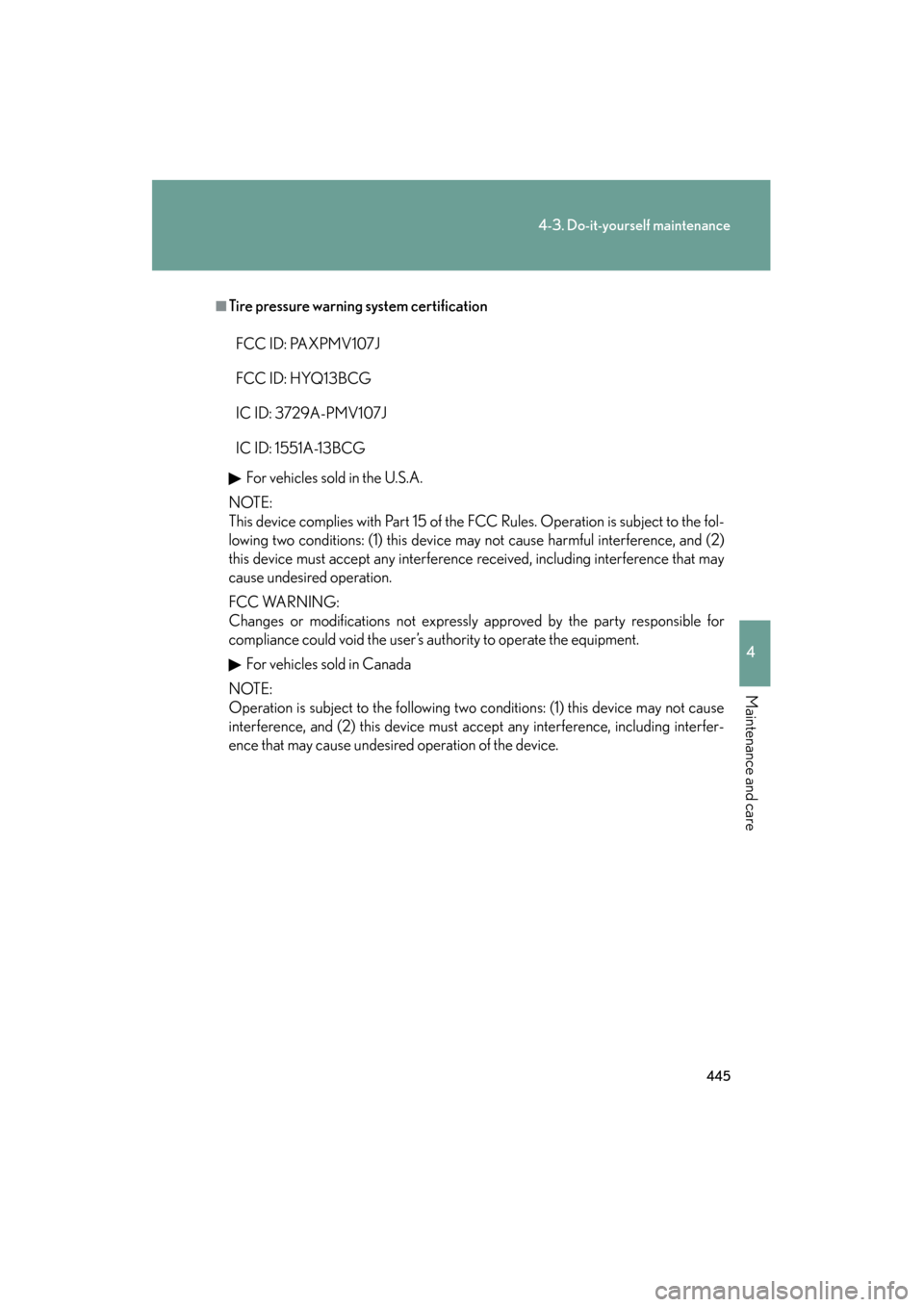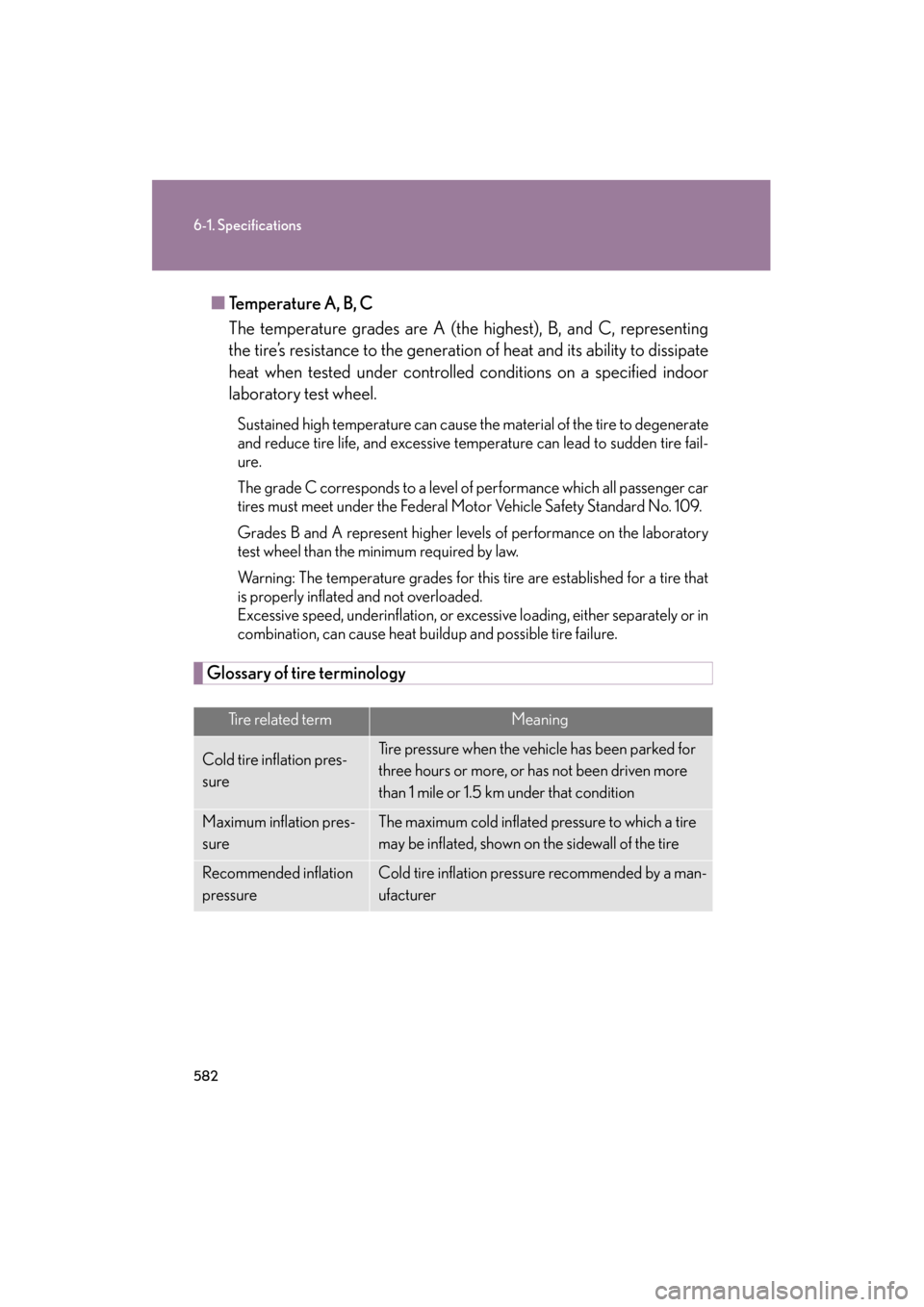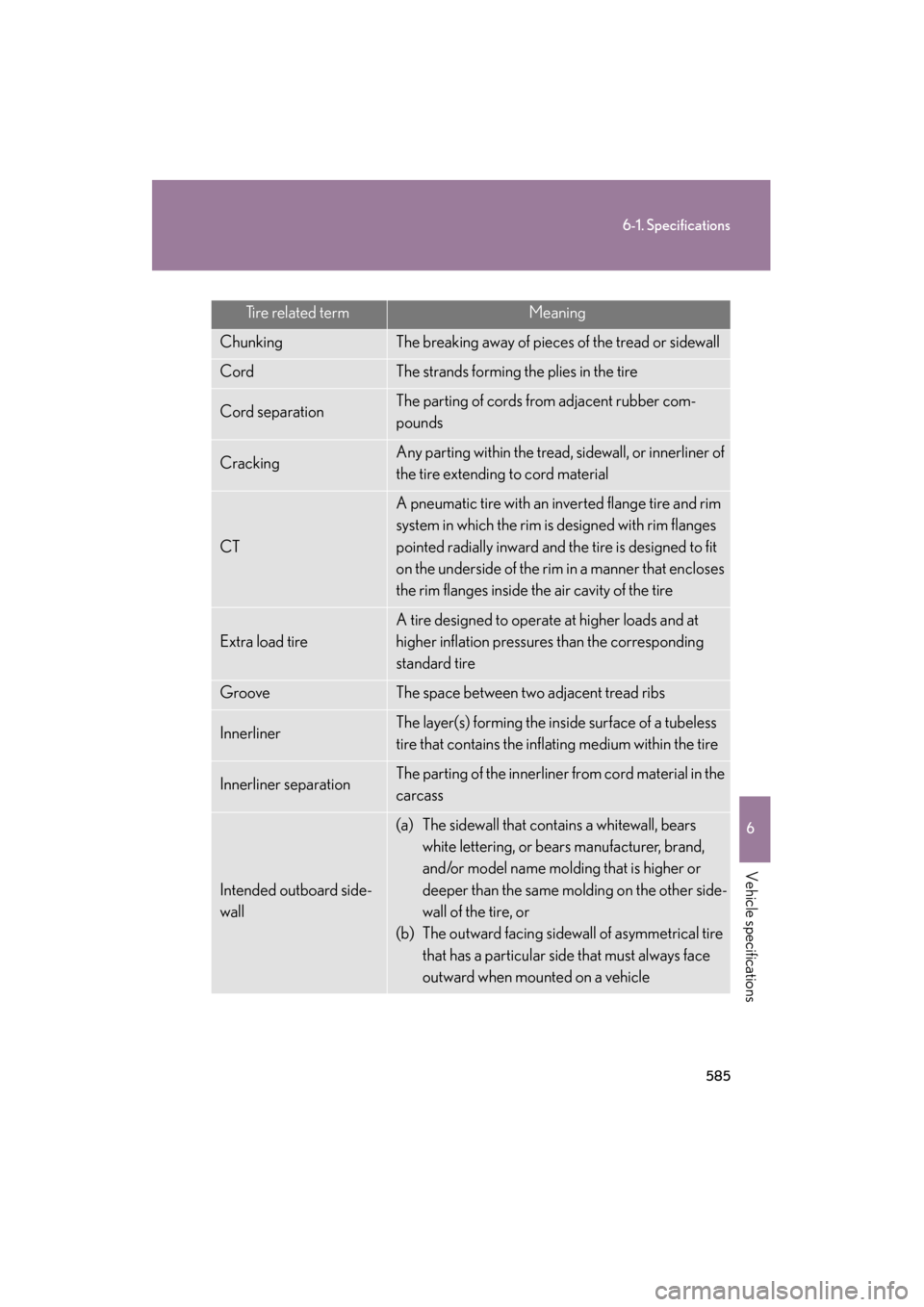2009 Lexus GS350 ESP
[x] Cancel search: ESPPage 446 of 622

445
4-3. Do-it-yourself maintenance
4
Maintenance and care
GS_G_U (OM30B43U)
April 27, 2009 10:48 am
■Tire pressure warning system certificationFor vehicles sold in the U.S.A.
NOTE:
This device complies with Part 15 of the FCC Rules. Operation is subject to the fol-
lowing two conditions: (1) this device may not cause harmful interference, and (2)
this device must accept any interference received, including interference that may
cause undesired operation.
FCC WARNING:
Changes or modifications not expressly approved by the party responsible for
compliance could void the user’s authority to operate the equipment.
For vehicles sold in Canada
NOTE:
Operation is subject to the following two conditions: (1) this device may not cause
interference, and (2) this device must accept any interference, including interfer-
ence that may cause undesired operation of the device. FCC ID: PAXPMV107J
FCC ID: HYQ13BCG
IC ID: 3729A-PMV107J
IC ID: 1551A-13BCG
GS_U_G.book Page 445 Monday, April 27, 2009 10:50 AM
Page 515 of 622

514
5-2. Steps to take in an emergency
GS_G_U (OM30B43U)
April 27, 2009 10:48 am
CAUTION
■Maintenance of the tires
Each tire, including the spare (if provided), should be checked monthly when cold
and inflated to the inflation pressure re commended by the vehicle manufacturer on
the vehicle placard or tire inflation pressu re label (tire and load information label).
(If your vehicle has tires of a different size than the size indicated on the vehicle
placard or tire inflation pressure label [t ire and load information label], you should
determine the proper tire inflation pressure for those tires.)
As an added safety feature, your vehicl e has been equipped with a tire pressure
monitoring system (TPMS-tire pressure wa rning system) that illuminates a low tire
pressure telltale (tire pressure warning light) when one or more of your tires is sig-
nificantly under-inflated. Accordingly, when the low tire pressure telltale (tire pres-
sure warning light) illuminates, you should stop and check your tires as soon as
possible, and inflate them to the proper pressure. Driving on a significantly under-
inflated tire causes the tire to overheat and can lead to tire failure. Under-inflation
also reduces fuel efficiency and tire tread life, and may affect the vehicle’s handling
and stopping ability.
Please note that the TPMS (tire pressure warning system) is not a substitute for
proper tire maintenance, and it is the driver’s responsibility to maintain correct tire
pressure, even if under-inflation has not reached the level to trigger illumination of
the TPMS low tire pressure telltale (tire pressure warning light).
Your vehicle has also been equipped with a TPMS (tire pressure warning system)
malfunction indicator to indicate when th e system is not operating properly. The
TPMS (tire pressure warning system) malfunction indicator is combined with the
low tire pressure telltale (tire pressure warning light). When the system detects a
malfunction, the telltale will flash for approximately one minute and then remain
continuously illuminated. This sequence will continue upon subsequent vehicle
start-ups as long as the malfunction exists . When the malfunction indicator is illumi-
nated, the system may not be able to detect or signal low tire pressure as intended.
TPMS (tire pressure warning system) malfunctions may occur for a variety of rea-
sons, including the installation of replacem ent or alternate tires or wheels on the
vehicle that prevent the TPMS (tire pres sure warning system) from functioning
properly. Always check the TPMS (tire pressure warning system) malfunction tell-
tale after replacing one or more tires or wheels on your vehicle to ensure that the
replacement or alternate tires and wheels allow the TPMS (tire pressure warning
system) to continue to function properly.
GS_U_G.book Page 514 Monday, April 27, 2009 10:50 AM
Page 583 of 622

582
6-1. Specifications
GS_G_U (OM30B43U)
April 27, 2009 10:48 am
■Temperature A, B, C
The temperature grades are A (the highest), B, and C, representing
the tire’s resistance to the generation of heat and its ability to dissipate
heat when tested under controlled conditions on a specified indoor
laboratory test wheel.
Sustained high temperature can cause the material of the tire to degenerate
and reduce tire life, and excessive temperature can lead to sudden tire fail-
ure.
The grade C corresponds to a level of performance which all passenger car
tires must meet under the Federal Mo tor Vehicle Safety Standard No. 109.
Grades B and A represent higher levels of performance on the laboratory
test wheel than the minimum required by law.
Warning: The temperature grades for this tire are established for a tire that
is properly inflated and not overloaded.
Excessive speed, underinflation, or excess ive loading, either separately or in
combination, can cause heat buildup and possible tire failure.
Glossary of tire terminology
Tire related termMeaning
Cold tire inflation pres-
sureTire pressure when the vehicle has been parked for
three hours or more, or has not been driven more
than 1 mile or 1.5 km under that condition
Maximum inflation pres-
sureThe maximum cold inflated pressure to which a tire
may be inflated, shown on the sidewall of the tire
Recommended inflation
pressureCold tire inflation pressure recommended by a man-
ufacturer
GS_U_G.book Page 582 Monday, April 27, 2009 10:50 AM
Page 586 of 622

585
6-1. Specifications
6
Vehicle specifications
GS_G_U (OM30B43U)
April 27, 2009 10:48 am
Tire related termMeaning
ChunkingThe breaking away of pieces of the tread or sidewall
CordThe strands forming the plies in the tire
Cord separationThe parting of cords from adjacent rubber com-
pounds
CrackingAny parting within the tread, sidewall, or innerliner of
the tire extending to cord material
CT
A pneumatic tire with an inverted flange tire and rim
system in which the rim is designed with rim flanges
pointed radially inward and the tire is designed to fit
on the underside of the rim in a manner that encloses
the rim flanges inside the air cavity of the tire
Extra load tire
A tire designed to operate at higher loads and at
higher inflation pressures than the corresponding
standard tire
GrooveThe space between two adjacent tread ribs
InnerlinerThe layer(s) forming the inside surface of a tubeless
tire that contains the inflating medium within the tire
Innerliner separationThe parting of the innerliner from cord material in the
carcass
Intended outboard side-
wall
(a) The sidewall that contains a whitewall, bears white lettering, or bear s manufacturer, brand,
and/or model name molding that is higher or
deeper than the same molding on the other side-
wall of the tire, or
(b) The outward facing sidewall of asymmetrical tire that has a particular side that must always face
outward when mounted on a vehicle
GS_U_G.book Page 585 Monday, April 27, 2009 10:50 AM
Page 588 of 622

587
6-1. Specifications
6
Vehicle specifications
GS_G_U (OM30B43U)
April 27, 2009 10:48 am
Tire related termMeaning
Pneumatic tire
A mechanical device made of rubber, chemicals, fab-
ric and steel or other materials, that, when mounted
on an automotive wheel, provides the traction and
contains the gas or fluid that sustains the load
Radial ply tire
A pneumatic tire in which the ply cords that extend to
the beads are laid at substantially 90 degrees to the
centerline of the tread
Reinforced tire
A tire designed to operate at higher loads and at
higher inflation pressures than the corresponding
standard tire
Section width
The linear distance between the exteriors of the side-
walls of an inflated tire, excluding elevations due to
labeling, decoration, or protective bands
SidewallThat portion of a tire between the tread and bead
Sidewall separationThe parting of the rubber compound from the cord
material in the sidewall
Snow tire
A tire that attains a traction index equal to or greater
than 110, compared to the ASTM E-1136 Standard
Reference Test Tire, when using the snow traction test
as described in ASTM F-1805-00, Standard Test
Method for Single Wheel Driving Traction in a
Straight Line on Snow-and Ice-Covered Surfaces,
and which is marked with an Alpine Symbol ( )
on at least one sidewall
GS_U_G.book Page 587 Monday, April 27, 2009 10:50 AM
Page 594 of 622

593
6-2. Customization
6
Vehicle specifications
GS_G_U (OM30B43U)
April 27, 2009 10:48 am
ItemFunctionDefault settingCustomizedsetting
Windshield
wipers and
washer
(
→P. 1 5 9 )
Switching operation when
the vehicle is stationaryONOFF
Drip prevention functionONOFF
Time elapsed before the
drip prevention function
operatesVa r i a b l e
depending on
the vehicle
speed
3 seconds
Illumination
(
→P. 3 5 6 )
Time elapsed before lights
turn off15 seconds7. 5 s e c o n d s
30 seconds
Operation when the
doors are unlockedONOFF
Operation after the
“ENGINE START STOP”
switch turned OFF
ONOFF
Front/rear personal lights
turned on when a door is
openedCorresponding light onlyAll lights
OFF
Foot lights ONOFF
Shift lever lightONOFF
Outer foot lightONOFF
Front/rear personal lights
turned on when the inte-
rior lights are switched
“ON”
ONOFF
Rear sunshade
(
→P. 3 76 )
Time elapsed before the
reverse operation feature
activates
0.7 seconds
0 seconds
0.9 seconds
1.2 seconds
GS_U_G.book Page 593 Monday, April 27, 2009 10:50 AM
Page 615 of 622

614
GS_G_U (OM30B43U)
April 27, 2009 10:48 am
What to do if...
What to do if...
A tire puncturesP. 5 3 1 /541If you have a flat tire
The engine does not start
P. 8 4Immobilizer system
P. 5 4 2If the engine will not start
P. 5 4 8If the 12 volt battery is discharged
The shift lever cannot be
moved outP. 5 4 3If the shift lever cannot be shifted
from “P”
The engine coolant temperature
gauge enters the red zone
Steam can be seen coming
from under the hood
P. 552If your vehicle overheats
The key is lostP. 5 4 4If you lose your keys
The 12 volt battery runs outP. 5 4 8If the 12 volt battery is discharged
The doors cannot be lockedP. 4 4Doors
The horn begins to soundP. 8 6Alarm
The vehicle is stuck in mud or
sandP. 5 5 5If the vehicle becomes stuck
GS_U_G.book Page 614 Monday, April 27, 2009 10:50 AM